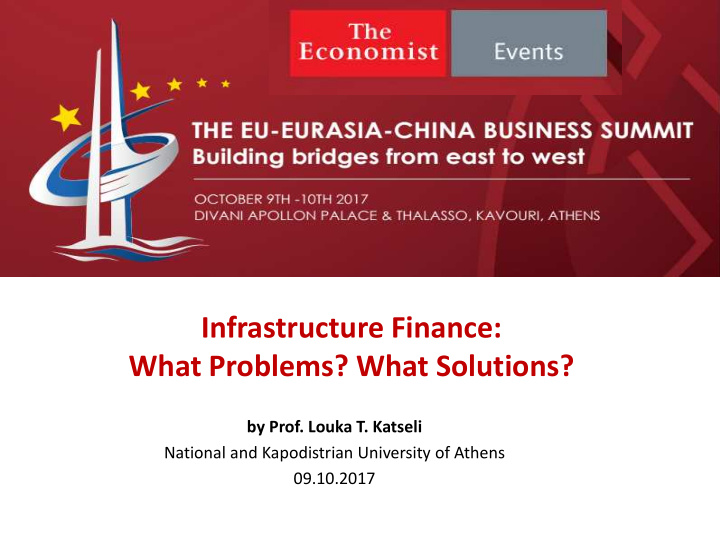



Infrastructure Finance: What Problems? What Solutions? by Prof. Louka T. Katseli National and Kapodistrian University of Athens 09.10.2017
I. Infrastructure – key enabler for post-2015 transformation • Economic transformation - alleviate growth constraints – Transport facilities – Utilities (water, gas, electricity) – ICT Networks • Social transformation - access to water, sanitation, energy for the poor, education, health – Educational establishments – Health facilities – Public buildings • Environmental transformation - from high to low carbon energy – Waste management – Renewable energy-related infrastructure – Energy-saving construction & reconstruction activities 2
II. Challenges to Infrastructure Investment Large infrastructure deficits at all levels of income (undersupply: $ 1 • trillion per year through 2020; additional $ 200-300bn to ensure low- carbon-emitting and climate resilient investment) Source : ODI et al, European Report on Development 2015 : Combining Finance and Policies to Implement a Transformative Post-2015 Development Agenda 3
II. Challenges to Infrastructure Investment (cont) • High sunk costs, lumpiness, uncertain returns, long gestation periods, high risks • High upfront capital requirements – investment in fixed assets under uncertainty • Complex risk profile (macroeconomic, political, technical, construction, revenue) ⇒ High return expectations by private investors – affordability? ⇒ High contingent liabilities for the public sector 4
II. Challenges to Infrastructure Investment (cont) Categories Barriers 1. The Investment • Lack of political commitment over the long term Opportunities • Regulatory instability • Fragmentation of the market among different level of governments • No clarity on investment opportunities • High bidding costs • Infrastructure investment opportunities in the market are perceived as too risky 2. The Investor • Lack of expertise in the infrastructure sector Capabilities • Problem of scale of pension funds • Regulatory Barriers • Short Termism of Investors 3. The Conditions • Negative Perception of the infrastructure value for Investment • Lack of transparency in the Infrastructure sector • Shortage of data on infrastructure projects • Need to report standards and performance measurement • Benchmarking • Regulation (Solvency II): Infrastructure Investment in Developing Countries = alternative investment (high capital requirements) 4. Impediments for • Reporting standards institutional • Performance measurement investors Source : OECD Pension Fund Investment in Infrastructure: Policy Actions, Working Paper 2011, G20-OECD Working Group on long-term financing 5
III. Policy matters for mobilization and effective use of infrastructure finance Infrastructure productivity: How to save $1 trillion a year (McKinsey 2012) Source : ODI et al, European Report on Development 2015 : Combining Finance and Policies to Implement a Transformative Post-2015 Development Agenda 6
III. Policy matters for mobilization and effective use of infrastructure finance (cont) Domestic action Ensure a strong and sustainable supply of bankable projects - “…the constraint is less one of • funding than an insufficient pipeline of bankable projects.” Contribute to building an enabling environment – “…the private sector will not invest in the • dark…” Design and implementation of a Medium Term Strategy for Infrastructural Development; • promotion of a Compact for Sustainable Infrastructure Finance for its implementation Capacity building in project selection, transaction structures, project, implementation, • monitoring and evaluation Regulatory reform to reduce lengthy and costly expropriation and legal procedures and to • enhance competition in transport service provision Custom reforms to lower waiting time and enhance transparency in border crossing • Strengthen planning and budgeting processes to make provisions for needed maintenance • costs; Improved quality and standards of public procurement in construction material Geographical concentration of productive activities to lower infrastructural needs (eg. • Industrial or Innovation Zones) Creation of accountable Specialized Agencies or Facilities for Infrastructure Development to • ensure transparency in concession awards, bidding processes and awards. Transparent state-business relations • 7
III. Policy matters for mobilization and effective use of infrastructure finance (cont) International action Global standards on PPPs contracts and government procurement in infrastructure • Work with MDBs to identify a set of exemplary projects – identify exemplary regional projects • Better donor co-ordination and harmonization to avoid duplication and promote coherence • on the ground Close the knowledge gap – MDB/OECD/private sector collaboration (data, benchmarking, • monitoring, learning platforms) => create a new asset class for long term investors 8
IV. Blended Finance and PPPs are necessary … Close the funding gap for project development – combine domestic and external funds and • develop specialized financial vehicles (EFSI-Junker Plan, Jessica, etc) Mixture of international public and private resources with national public expenditures principal source (40-70%) Mobilise DFIs and MDBs (EIB, EBRD,IFC) to provide long-term finance, necessary credit and risk- • mitigation instruments with significant blending (private finance, ODA, technical assistance, OOF, risk-mitigation instruments) Make funding available under appropriate terms - local currency debt markets (infrastructure • bonds), local financial intermediaries, MDBs: crowding in private capital through the use of risk mitigation instruments and co-financing by Institutional Investors Develop local capital markets – more effort to create incentives for local financing/local currency • bond markets Extend use of bond financing and PPPs. • Sources: HLP on Infrastructure Investment – Recommendations (2011) ODI et al, European Report on Development 2015 : Combining Finance and Policies to Implement a Transformative Post-2015 Development Agenda 9
V. PPPs around the world (2001-2016) Europe has been historically • the most active. Recently the distribution has become more even with Australia, UK, Canada, Chile, France, India, Japan and Mexico taking the lead. PPPs mostly in • transportation (54%) and Social Infrastructure (31%) Junker Plan (EFSI) an • important step (16 projects approved) Greece in the lead : 3 rd • position in EU after UK, France with 7 contracts worth 465 mil EUR Source : EPEC 10
Recommend
More recommend